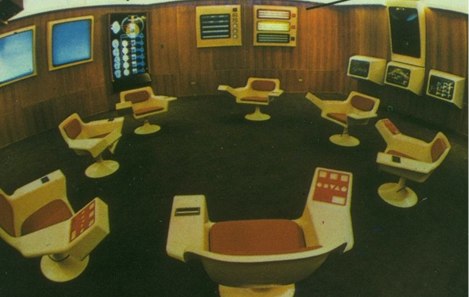In 1970 Chile Attempted To Control Their Entire Economy With An iPhone
Posted by Justin on August 1st, 2011
It is the dawning of the computer age and anything is possible. Computations are reduced to milliseconds, data which previously required warehouses and staffs for maintenance can now be stored and sorted with ease and in Santiago, Chile a few very ambitious fellows assumed that these breakthroughs could solve a larger problem.
They were going to take the Chilean economy out of the greedy hands of humans and the capitalist influences that corrupt them.
After Salvador Allende was elected as the first socialist president in the country’s history, he began to nationalize large chucks on the economy including local branches of out-of-state corporations. Many companies that were not nationalized, fled Chile leaving infrastructure (machinery, warehouse space, trucks, employees) behind for the government to take over.
The room you see above was HQ to Cybersyn, a project designed by British research scientist Stafford Beer where telex machines fed raw data into a custom designed program which would in turn create projections and issue guidance on further production and distribution to the newly nationalized factory. It was all controlled in the room pictured above. Boxy, plastic swivel chairs which one could easily picture a subordinate to Admiral Ackbar toiling away in dot the center while glowing panels displaying data ring the walls.
Problem was, by all accounts, it didn’t work. While some declare it to be a forgotten, neglected seed that could have flowered into an egalitarian “socialist internet,” most of the evidence states that not unlike the data display wall mounts (which were non-functioning stage props) the entire project never lived up to its lofty goals.
To put it in perspective, economist Alex Tabarrok points out that the IBM 360 units used in Cybersyn are considerably less powerful than an iPhone.
In this excellent 25-minute video essay about the Cybersyn, authors Jeremiah Axelrod and Greg Borenstein argue that the intentionally futuristic design of the control room was so effective at swaying Allende and his government into believing that the future was now and Cybersyn could be successful that it ultimately doomed the project.
When 1973 came and the military coup by Augusto Pinochet deposed Allende from office, Cybersyn was shuttered and the telex machines mothballed. As for those chairs, the world may never know.
August 1st, 2011 at 9:10 pm
This was a very interesting read. Makes you wonder what a modern Utopian leader could come up with the information technology available today. I can imagine a would be benevolent Dictator putting control of people’s lives in the unfeeling cold hands of computer networks to maximize the common good. The Computer network would dictate where to eat what to wear , when to meet with friends ect. All aspects of your life would be ruled by the machine. Oh wait, is that not what Facebook does? Way to go Comrade Zuckerberg.
In all seriousness, its a pity so see all the suffering well meaning idiots have wrought when they decide that the individual is not smart enough t decide for him/herself. This was very interesting read indeed.
August 1st, 2011 at 9:12 pm
Approve.
Andrew
Andrew Mayne
//website andrewmayne.com
//Twitter @AndrewMayne